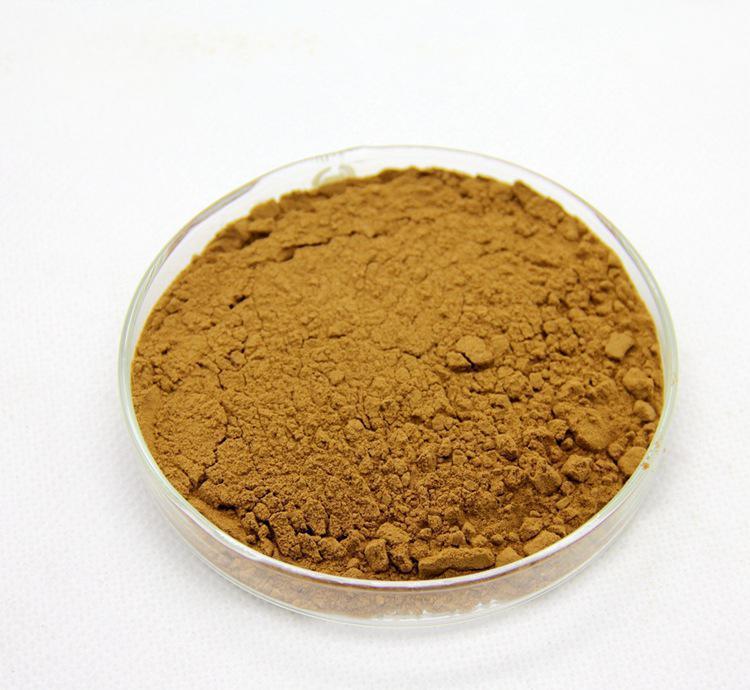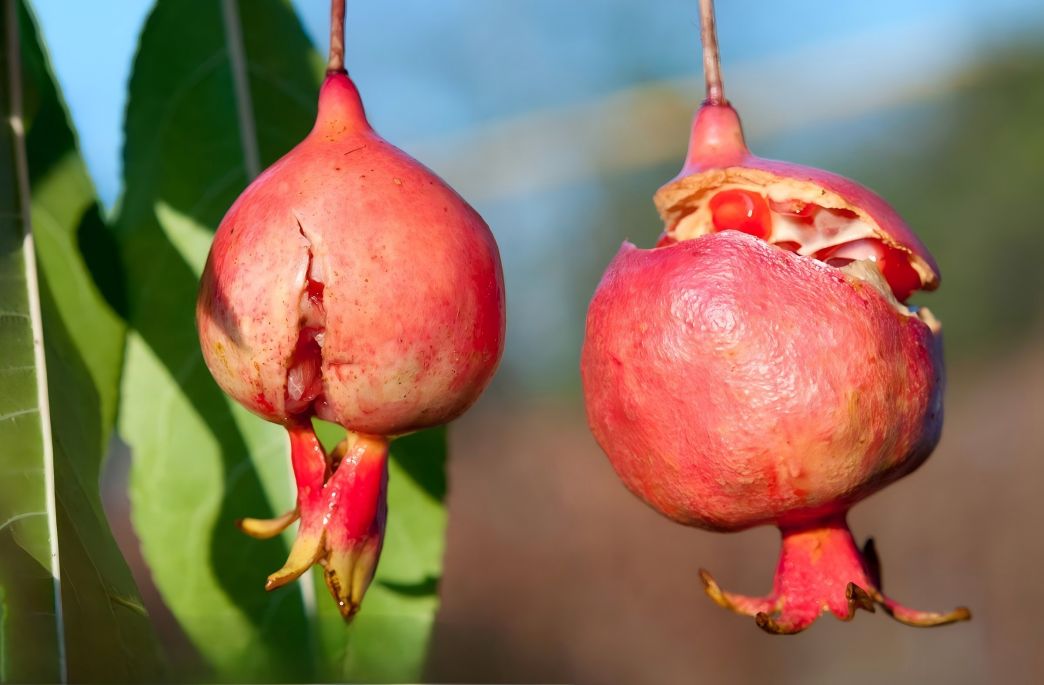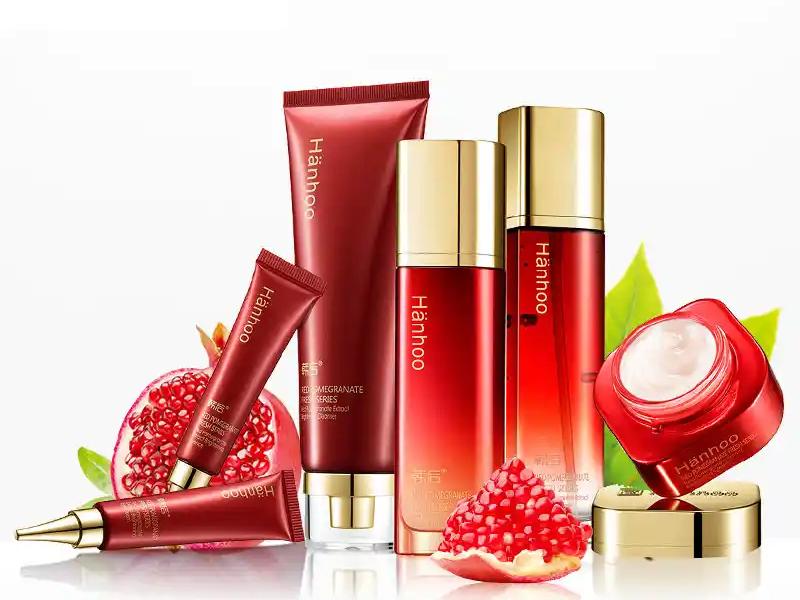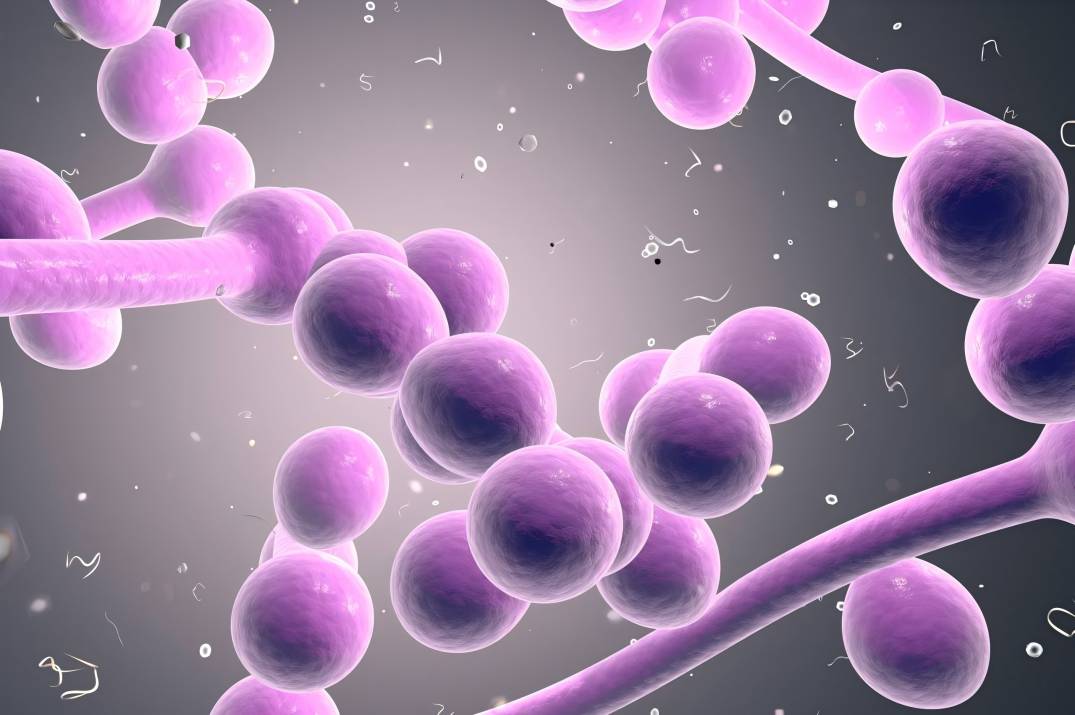What Are the Benefits of Pomegranate Peel Extract Powder?
Pomegranate is a medicinal and edible fruit, which is more commonly cultivated in China and is very rich in resources, not only rich in nutrients, but also rich in phenols and other active ingredients that are beneficial to human health. Pomegranate glycosides, ellagic acid, gallic acid and epicatechin are the main components of pomegranate polyphenols[1] , which have antioxidant[2-3] , anti-tumor, antibacterial[4-5] , anti-atherosclerosis, anti-cancer[3,6] , and cardiovascular disease[7-8] effects, and are suitable for use in the fields of medicine, food, and cosmetics[9] .
It is well known that pomegranate polyphenols mainly exist in pomegranate peel, which is a by-product of pomegranate processing. Except for a small amount of pomegranate peel used as medicinal herbs, most of the pomegranate peel is regarded as agricultural waste, which is wasteful of resources and leads to environmental pollution. Therefore, the study of the components of pomegranate peel and the further development of its active ingredients are of great significance in the effective utilization of biological resources and the protection of the environment. The main active components, extraction methods and biophysiological activities of pomegranate rind were reviewed, aiming to provide reference for the comprehensive utilization of pomegranate rind in high value.
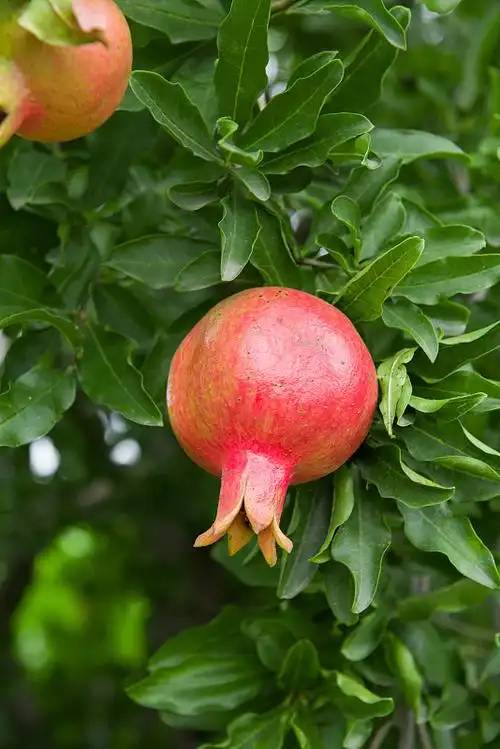
1 The main components of pomegranate peel polyphenols
The extracts of pomegranate rind are complex and diversified, among which the highest content is tannins, accounting for 30% of the total mass of pomegranate rind, with anthranilic acid and ellagic acid as the main components; flavonoids accounted for 6.65% of the total mass of pomegranate rind, which are mainly quercetin, anthocyanin, epicatechin and so on, especially anthocyanin with the highest content; in addition, pomegranate rind contains gallic acid, caffeic acid, ferulic acid and other organic acids [10]. In addition, pomegranate peel also contains gallic acid, caffeic acid, ferulic acid and other organic acids [10-11].
1.1 Andrographidine
Andrographidine is a unique phenolic constituent of pomegranate with various pharmacological effects, which cannot be synthesized artificially at present and can only be obtained by natural extraction. The hydrolysis of andrographolide is more dependent on pH than enzymatic reaction, and the optimal hydrolysis pH is 8[12] . Ellagic acid is the hydrolysis product in vivo, which can be further metabolized to urolithin in the intestinal tract. The phenolic substances in the polyphenolic extract of pomegranate rind were identified by high performance liquid chromatography (HPLC), and the content of andrographolide was as high as 65.75%[13] . Andrographidine is widely used in food and cosmetics for its antioxidant properties.
1.2 Ellagic acid
Ellagic acid has hypolipidemic, antioxidant, anticancer and anti-inflammatory properties. Wang Yizi [14] found that ellagic acid has a certain inhibitory function on endometrial cancer through the information biology approach, and its mechanism of action is realized through the regulation of the PI3K signaling pathway. At the same time, ellagic acid ameliorated the toxicity of lipids in H9c2 cardiomyocytes induced by palmitic acid, which may be related to the endoplasmic reticulum stress-mitochondrial apoptosis pathway[15] . In addition, ellagic acid has been shown to protect against the immunological damage caused by beryllium sulphate in SD rats, such as pathological tissue damage in the spleen and abnormal proliferation of splenic lymphocytes, which is mainly dependent on its antioxidant and anti-apoptotic effects[16] . Therefore, ellagic acid is widely used in health food, medicine and cosmetics.
2 Extraction of polyphenols from pomegranate skin
There are many kinds of polyphenols in the plant body, and with the deepening of research, on the basis of traditional extraction and the development of new technologies, more convenient, effective and economical extraction technologies such as mechanochemical-assisted extraction, ultrasonic extraction, microwave-assisted extraction, supercritical fluid extraction and enzyme-assisted extraction have come into being, and their joint use has also been gradually explored and applied.
2.1 Mechanical-chemical assisted extraction
Mechanochemical assisted extraction is the use of mechanical crushing and solid phase chemical additives. Mechanical pulverization refers to the micronization of plant materials to promote the destruction of cellular structure, in order to increase the specific surface area of the particles, while solid-phase chemical additives are reacted with the components to be extracted to increase their solubility in the extractant, thus exposing the components to be extracted, and achieving the purpose of increasing the extraction rate.Rinc6n E et al. [17] extracted polyphenols from Mediterranean medicinal lauric acid by using the mechanochemical method. Rinc6n E et al. Li DG et al [18] investigated the extraction process of tea polyphenols using three extraction methods, and found that the extraction rate of tea polyphenols by mechanochemical method > microwave-assisted extraction > ultrasound-assisted extraction. Mechanochemical assisted extraction can reduce the extraction of all the time, but also can improve the extraction efficiency, and can use water as a solvent to complete the extraction at room temperature.
2.2 Ultrasonic extraction
Ultrasonic extraction is the use of high-frequency wave introduction leads to the perturbation of the solute - solvent mixture, in order to make the cell structure rupture and solvent diffusion, which is conducive to the dissolution of the active ingredient of the cell into the solvent. Compared with the traditional extraction technique, it is simple to operate, which not only greatly shortens the extraction time but also has a high extraction rate, and at the same time, it has little damage to the active ingredients and can reduce the degradation or discoloration of the active ingredients, which is suitable for the extraction of plant polyphenols. Deng Yong et al [19] used ultrasonic extraction of pomegranate skin polyphenols, and compared with the traditional extraction method, proved that ultrasonic extraction not only greatly reduces the extraction time, and the extraction rate has been improved.
2.3 Microwave-assisted extraction
Microwave-assisted extraction is the use of high-frequency electromagnetic waves through the extraction medium, has a strong cell wall-breaking ability, can make the active ingredients to be fully released, microwave extraction and traditional extraction methods and ultrasound-assisted extraction compared to microwave-assisted extraction can be extracted in a short period of time, and more environmentally friendly and energy-saving. Zhang Lijun et al [20] utilized four extraction methods (ultrasonic extraction, enzyme-assisted extraction, microwave extraction and Soxhlet extraction) to extract flavonoids from pomegranate peel and compared them, and the results showed that microwave-assisted method had the highest extraction efficiency.
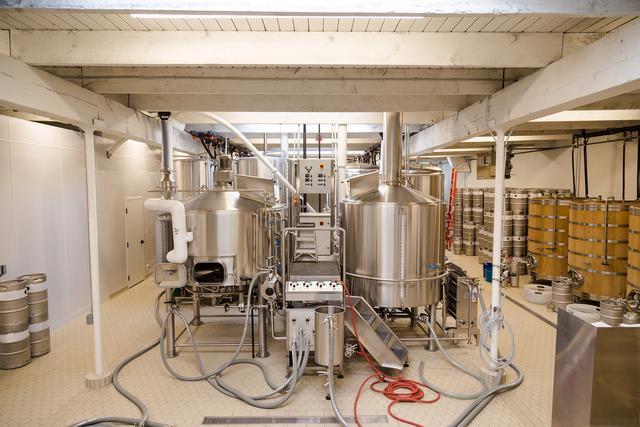
2.4 Supercritical fluid extraction method
Supercritical fluid extraction is a technique that uses supercritical fluids (e.g. CO2) as extraction solvents to obtain biologically active substances. In addition, given that it is carried out in the absence of light and oxygen, supercritical fluid extraction significantly reduces oxidation and is more suitable for the extraction of heat-sensitive natural products because of the lower temperatures at which it is used. This method has the advantages of high extraction efficiency, no oxidative loss, and pure natural and no chemical pollution, but the industrialization cost due to high pressure limits its large-scale application. Yan Xueqin et al [21] used supercritical fluid extraction to extract proanthocyanidins from pomegranate rind, and through the optimization of the extraction process, the extraction rate of proanthocyanidins reached 3.40% with high purity.
2.5 Enzyme-assisted extraction
Enzyme-assisted extraction is based on the structural composition of plant cells by adding appropriate enzymes to degrade the cell wall structure and promote the release of internal substances, which is more effective in destroying the cell wall and reducing the loss of active compounds compared with mechanical treatment[22] . Mushtaq M et al[23] introduced 3.8% cocktail enzyme into pomegranate peels pretreated for 85 min at pH 6.7 and 41 ℃. Mushtaq M et al [23] introduced 3.8% cocktail enzyme into pomegranate rind at pH 6.7 and temperature 41 ℃ for 85 min, and the extraction efficiency was 3 times higher than that of traditional solvent extraction.
3 Biological activities and applications of pomegranate peel polyphenols
Pomegranate rind polyphenols have many biological effects and have been used in food, medicine and cosmetics.
3.1 Antioxidant properties
Antioxidant performance has more possibilities, its main performance is a strong reducing property, easier to react with oxygen, and peroxides to hinder the oxidation process, and the scavenging of free radicals and some metal ions to chelate reaction, thus reducing oxidative losses, mainly used in preservation and anti-aging cosmetics. The strong antioxidant activity of pomegranate skin polyphenols is attributed to their high content of phenolic hydroxyl groups. Cao Yungang et al[24] examined the synergistic effect of hydrolyzed pea protein and pomegranate peel extract on fat oxidation and found that it had a certain inhibitory effect.
Drini Z et al[25] investigated the effect of pomegranate peel extract on the oxidative stability of pomegranate seed oil and found that pomegranate peel extract could improve the quality and stability of sunflower oil; Turgut S S et al[26] added pomegranate peel extract to beef meatballs and demonstrated that pomegranate peel extract can improve the quality of sunflower oil, and also the stability of pomegranate oil. Turgut S S et al [26] added pomegranate peel extract to beef meatballs and demonstrated that pomegranate peel extract was effective in slowing down the oxidation of fats and proteins during frozen storage; Ying Li [27] found that pomegranate peel extract could scavenge free radicals and inhibit fat and protein oxygenation in meat products, thus improving the quality of meat products. A study compared the antioxidant effects of three natural antioxidants, including pomegranate rind polyphenols, on palm oil, rapeseed oil and soybean oil, among which pomegranate rind polyphenols were the most effective, and can be used as a new type of natural antioxidant in the edible oil processing industry [28]. With the in-depth research on the antioxidant properties of polyphenols, pomegranate peel polyphenols have been gradually used as a natural antioxidant in cosmetics and food quality improvement and preservation.
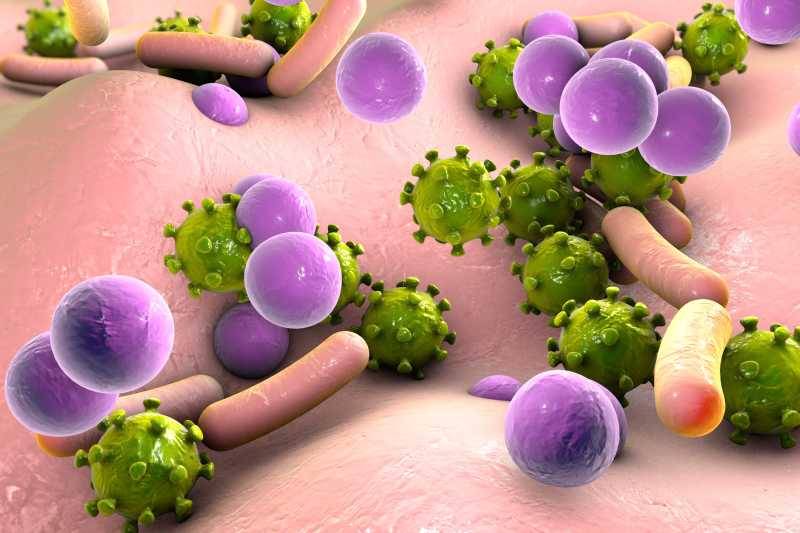
3.2 Bacteria inhibition
Yuan L et al [29] showed that pomegranate peel polyphenols can treat intestinal diseases, especially those caused by bacterial infections, depending on their good bacteriostatic effects, such as dysentery bacilli, staphylococci, and coliform bacilli, etc. In a study of its application to shrimp and fish preservation and storage, Yuan G and Wu A J et al [30-32] found that pomegranate peel polyphenols could prolong the shelf-life of shrimp and fish to a certain degree, and also maintain the nutrient and food quality of the substance. Wu W F et al [33] found that the aqueous extract of pomegranate rind had good inhibitory effect on Salmonella and Salmonella enteritidis in a study using aqueous extract of pomegranate rind. Meanwhile, Hong Jun et al [34] used pomegranate peel extract to inhibit five foodborne pathogens in vitro, and the results showed good inhibitory effects, indicating that pomegranate peel extract can be used as a food preservative, which lays the foundation for the use of pomegranate peel as a potential preservative and freshness-keeping agent in food.
3.3 Anti-inflammatory
Gonzalez-Tr-ujano M E et al [35] showed that pomegranate peel extract not only reduces pain, but also has a certain effect on alcohol-induced gastric injury; Du L et al [36] investigated the anti-inflammatory effects of pomegranate peel polyphenols on RAW264.7 macrophages and showed that it has certain anti-inflammatory effects, and its mechanism of action may be different from that of pomegranate peel polyphenols. Du L et al [36] examined the anti-inflammatory effect of pomegranate peel polyphenols on RAW264.7 macrophages and showed that it has some anti-inflammatory effect, and its mechanism of action may be related to the inhibition of the activation of MAPKs; Du L [37] also showed that pomegranate peel polyphenols can reduce and inhibit the secretion and gene expression of pro-inflammatory cytokines; in addition, pomegranate peel polyphenols also have an anti-acne effect [38]. In addition, pomegranate rind polyphenols also have anti-acne effects[38] . It can be seen that pomegranate rind polyphenols have great potential in the treatment of anti-inflammatory and related diseases.
3.4 Cancer prevention and anti-tumor effects
It has been shown that pomegranate juice and isolated pericarp extracts inhibit the proliferation, distribution and colony formation of prostate cancer cell lines, and the aqueous extract of pomegranate rind has a stronger anticancer effect[39] . Shukla S et al.[40] found that pomegranate pericarp polyphenols could have an effect on altering the cell cycle of the prostate cancer cell DU145; Song B et al.[41] found that the inhibition of liver cancer was a major cause of liver cancer. In addition, pomegranate peel extract can effectively inhibit breast cancer cells, ovarian cancer cells and lung adenocarcinoma cells[42] . The above studies show that pomegranate peel polyphenols have great potential in tumor inhibition and anticancer.
3.5 Cardiovascular protection
Atherosclerosis is prone to cause cardiovascular and cerebrovascular diseases, and hyperlipidemia is the main cause. Pomegranate peel is rich in active ingredients that can regulate lipid metabolism in metabolic disorders such as atherosclerosis, thereby alleviating the development of the disease, and its mechanism of action may be related to the improvement of oxidative stress and inflammation, in order to achieve cardiovascular protection by lowering blood lipids[43-44] . Zhao Ruiqi [45] found that pomegranate peel extract has some hypolipidemic and body weight reduction effects in SD rats fed with high-fat chow; Aviram M et al [8] found that pomegranate peel extract has anti-atherosclerotic effects, and pomegranate peel extract has also been shown to improve the effects of hyperlipidemia [46]. In addition, pomegranate peel polyphenols can effectively regulate the blood levels of indicators related to cardiovascular diseases, which can effectively inhibit the occurrence of cardiovascular diseases.

3.6 Other effects
In addition to the above physiological functions, many studies have found that pomegranate peel polyphenols have the functions of weight loss, hypoglycemia and neuroprotection.
3.6.1 Weight loss
Obesity is caused by excessive accumulation of fat in the body, which not only causes physical inconvenience, but also the occurrence of a variety of diseases related to it, so fat reduction and weight loss are issues of concern in today's society. Studies have shown that pomegranate peel polyphenols have good lipid-lowering effect, and Wang Zhou [47] found that it has obvious inhibitory effect on α-amylase; Hosseini B et al [48] found that it can significantly reduce the expression level of serum glucose and total cholesterol, and make the expression of HDL cholesterol increased, which shows that the pomegranate peel extracts have a certain role in lipid-lowering and weight-loss and can reduce the obesity-related diseases. These findings not only indicate that pomegranate peel has a certain effect on fat reduction and slimming[49-50] , but also may be of great help in the clinical treatment of hyperlipidemia.
3.6.2 Hypoglycemia
Pomegranate peel polyphenols were found to have a protective effect on renal lesions in a diabetic rat model, and may be useful in the treatment of diabetes and its complications [51]. In addition, the inhibition of α-amylase and α-glucosidase activities by pomegranate peel extracts[52] may provide a basis for the use of pomegranate peel polyphenols in the management of blood glucose levels in type II diabetes mellitus and borderline patients.
3.6.3 Improvement of memory
Yang Chengwu[53] concluded that pomegranate glucoside can effectively regulate the intestinal flora of mice with Alzheimer's disease, thereby significantly improving their cognitive function, suggesting that pomegranate glucoside may be a potential proprietary Chinese medicine for improving cognitive function in Alzheimer's disease patients.
4 Conclusion
Pomegranate rind is rich in polyphenols, which have good physiological activity and medicinal value. According to the results of the current study, pomegranate rind polyphenols have shown great potential in many fields such as food, and they have not yet been well utilized in pomegranate production and processing. The polyphenols in pomegranate mainly exist in the pomegranate peel, and if the polyphenols in the pomegranate peel can be effectively utilized, it can not only improve the utilization of resources and the protection of the environment, but also increase the added value of the pomegranate industry. Therefore, the study of highly active polyphenols in pomegranate peel has important economic and social benefits.
References:
[1] Teng Bi-Wei. Research and application progress of pomegranate peel [J] . Popular Science and Technology , 2013, 15(2):59-61.
[2] Niegi P S ,Jayaprakasha G A ,Jena B S. Antionxidant and anti-mutagenic activities of pomegranate peel extracts [J] . Food Chem ,2003 ,80(3):393-397.
[3] Kim N D , Mehta R , Yu W P , et al. Chemoprewentive and adjuvant therapeutic potential of pomerganale(Punica granatum) for human breast cancer [J] . Breast Cancer. Res Treat ,2002(7):203-217.
[4] Ismail T , Sestili P. ,Akhtar S. Pomegranate peel and fruit extracts :A review of potential anti-inflammatory and anti- infective effects [J] . J Ethnopharmacol ,2012(2): 397- 405.
[5] Dahham S S , Ali M N , Tabassum H , et al. Studies on antibacterial and anti-fungal activity of pomegranate(Puni- ca granatum L.) [J] . Am Eurasian J Agric Environ Sci, 2010 ,9(3):273-281.
[6] Lansky E P , Newman R A. Punica granatum(pomegr - anate) and its polential for prevention and treatment of in- flammation and cancer [J] . Ethnopharmacol , 2007(2): 177-206.
[7] Aviram M , Rosenblat M. Pomegranate protection against cardiovascular diseases [J] . Evid Based Complement Al- ternat Med ,2012(12): 1-20.
[8] Aviram M , Volkova N , Coleman R , et al. Pomegranate phenolics from the peels ,arils ,and flowers are antiathero- genic: studies in vivo in atherosclerotic apolipoprotein E - deficient(EO) mice and in vitro in cultured macrophages and lipoproteins [J] . Journal of Agriclural and Food Che - misty ,2008 ,56(3): 1 148-1 157.
[9] Wang Yuan. Research on the extraction of pomegranate leaf polyphenols and its application in anti-aging cosmetics [D] . Kaifeng: Henan University , 2019.
[10] Han Lingling. Research progress of pomegranate polyphenols [G] // Proceedings of the Chinese Horticultural Society. Beijing: Chinese Society of Horticulture, 2012: 512-517.
[11] Li J K ,He X Y ,Li M Y ,et al. Chemical fingerprint and quantitative analysis for quanlity control of polyphenols ex- tracted from pomegranate peel by HPLC [J] . Food Chem- istry ,2015(17):7-11.
[12] Lipinska L , Klewicka E , Sojka M. The structure , occur- rence and biological activity of ellagitannins :A general re- view [ J] . Acta Scientiarum Polonorum. Technologia Ali- mentaria ,2014 , 13(3):289-299.
[13] Li Jianke, Li Guoxiu, Zhao Yanhong, et al. Analysis of polyphenol composition and antioxidant activity of pomegranate peel [J]. Chinese Agricultural Science , 2009 , 42(11): 4 035-4 041.
[14] WANG Yizi. Effects of ellagic acid on endometrial cancer cells through PI3K signaling pathway and its molecular mechanism [D]. Shenyang: China Medical University, 2021.
[15] Zhou Yao. Protective effect of ellagic acid on lipotoxic injury of H9c2 cardiomyocytes [D]. Xianning: Hubei Institute of Science and Technology , 2021.
[16] Lei Yuandi. Protective Effect of Ellagic Acid on Beryllium Sulfate-induced Immune Damage in SD Rats [D]. Hengyang: Nanhua University, 2021.
[17] Rinc6n E , Balu A M , Luque R , et al. Mechanochemical extraction of antioxidant phenolic compounds from Mediter- ranean and medicinal Laurus nobilis: Acomparative study with other traditional and green novel techniques [J] . Industrial Crops & Products ,2019(14): 1-6.
[18] LI Da-Gang, XU Yao-Zong, WANG Zhi-Wen, et al. CCD method for analyzing three auxiliary extraction processes of tea polyphenols [J]. Tea Letters , 2021 , 48(4):712- 716. [19] Deng Yong, Liu Donghong. Effect of ultrasonic treatment on the extraction effect of pomegranate peel polyphenols [J] . Journal of Food Science and Technology , 2021 , 39(1):65-69.
[20] Zhang Lijun , Li Min , Wang Jing , et al. Extraction and antioxidant study of flavonoids in pomegranate peel [J]. Chemical Engineer , 2021 , 35(9):65-68.
[21] YAN Xueqin, MA Caimei. Optimization of supercritical CO2 extraction process of proanthocyanidins from pomegranate peel [J] . Modernized Agriculture , 2018(11):29-32.
[22] Saad N ,Louvet F ,Tarrade S ,et al. Bressollier [J] . Food Sci ,2019(6): 1 371-1 381.
[23] Mushtaq M , Sultana B ,Akram S , et al. Research & Re- views [J] . Microbiol. Biotechnol ,2016(2):27-34.
[24] Cao Yungang, Li Zhaorui, Han Xinrui, et al. Characterization of hydrolyzed pea protein and its synergistic antioxidant effect with pomegranate peel extract [J] . Food and Fermentation Industry , 2020 , 46(16):30-36.
[25] Drini Z. ,Mudri J. ,Zduni G. ,et al. Effect of pomegranate peel extract on the oxidative stability of pomegranate seed oil [J] . Food Chemistry ,2020(33): 127 501-127 515.
[26] Turgut S S , Isikci F , Soyer A. Antioxidant activity of pomegranate peel extract on lipid and protein oxidation in beef meatballs during frozen storage [ J] . Meat Science, 2017(12): 111-119.
[27] Li Y. Study on the effect of pomegranate peel extract on the quality of pork patties and the intrinsic mechanism [D] . Xi'an: Shaanxi University of Science and Technology , 2021.
[28] PAN Dongsheng, TAN Zushun, GUO Yanhua, et al. Antioxidant effects of pomegranate peel polyphenols on vegetable oils [D]. Antioxidant effects of pomegranate peel polyphenols on vegetable oils [J]. Food Industry , 2021 , 42(12):264-267.
[29] YUAN Li, GAO Ruichang, TIAN Yongquan. Nutritional and health care functions and development and utilization of pomegranate [J] . Agricultural Engineering Technology (Processing of Agricultural Products), 2007(10):38-40.
[30] Yuan G , Lv H , Yang B , et al. Physical properties , an- tioxidant and antimicrobial activity of chitosan films con- taining carvacrol and pomegranate peel extract [J] . Molec- ules ,2015 ,20(6): 11 034-11 045.
[31] Yuan G ,Lv H ,Tang W ,et al. Effect of chitosan coating combined with pomegranate peel extract on the quality of Pacific white shrimp during iced storage [J] . Food Control, 2016 ,59(1):818-823.
[32] Wu A J , Jahncke M L , Eifert J D , et al. Pomegranate peel(Punica granatum L.) extract and Chinese gall(Galla chinensis) extract inhibit Vibrio parahaemolyticus and Lis- teria monocytogenes on cooked shrimp and raw tuna [ J] . Food Control ,2016 ,59(1):695-699.
[33] Wu W F ,Solval K M ,Chen J R. Inhibitory activity of aq- ueous extracts of pomegranate peel products and juice pow- der against Salmonella enterica [ J] . LWT , 2022(15): 112 934-112 956.
[34] Hong Jun, Li Wenyu, Wei Xiayi, et al. Bacteriostatic activity of pomegranate peel extract and its effect on preservation of cooled chicken [J] . China Seasoning, 2020, 45(3): 73-76, 82.
[35] Gonzalez-Trujano M E,Pellicer F,Mena P,et al.Ant-in- ociceptive and anti-inflammatory activities of a pomegranate(Punica granatum L.) extract rich in ellagitannins [J] . International Journal of Food Sciences and Nutrition ,2015 , 66(4):395-399.
[36] Du L ,Li J K ,Zhang X T ,et al. Pomegranate peel polyphe- nols inhibits inflammation in LPS -induced RAW264.7 macrophages via the suppression of MAPKs activation [J] .Journal of Functional Foods ,2018(43):62-69.
[37] Du Lin. Research on the regulatory effect of pomegranate peel polyphenols on chronic low-grade inflammation and its molecular mechanism [D] . Xi'an: Shaanxi Normal University , 2019.
[38] Gao F. Mechanism of Pomegranate Peel Polyphenol Cream Inhibiting NLRP3 Inflammatory Vesicles in Anti-Acne [D] . Changsha: Hunan University of Traditional Chinese Medicine , 2021.
[39] Chaves Fernanda Machado ,Pavan Lsadora Carolina Betim, Da Silva Luiz Guilherme Salvino , et al. Pomegranate juice and peel extracts are able to inhibit proliferation ,migration and colony formation of prostate cancer cell lines and modulate the Akt/mTOR/S6K signaling pathway. [J] Plant Foods Hum Nutr ,2020(7):54-62.
[40] Shukla S ,Gupta S. Molecular mechanisms for apigenin-in- duced cell-cycle arrest and apoptosis of hormone refractory human prostate carcinoma DU145 cells [J] . Molecular Ca- rcinogenesis ,2004 ,39(2): 114-126.
[41] Song B , Li J , Li J. Pomegranate peel extract polyphenols induced apoptosis in human hepatoma cells by mitochondrial pathway [J] . Food and Chemical Toxicology , 2016(9): 158-166.
[42] Mat Jusoh Siti Asmaa ,AJH Ail. S Azman. Growth inhibito- ry effects of crude pomegranate peel extract on chronic myeloid leukemia , K562 cells [ J] . International Journal of Applied and Basic Medical Research ,2015(2): 100-105.
[43] Hou C ,Zhang W , Li J , et al. Beneficial effects of pome - granate on lipid metabolism in metabolic disorders [J] . Mo- lecular Nutrition & Food Research ,2019(16):1 800 773- 1 800 785.
[44] Parmar H S , Kar A. Medicinal values of fruit peels from Citrus sinensis , Punica granatum , and Musa paradisiaca with respect to alterations in tissue lipid peroxidation and serum concentration of glucose , insulin , and thyroid hor- mones [J] . Journal of Medicinal Food , 2008 , 11(2): 376-381.Journal of Functional Foods ,2018(43):62-69.
[37] Du Lin. Research on the regulatory effect of pomegranate peel polyphenols on chronic low-grade inflammation and its molecular mechanism [D] . Xi'an: Shaanxi Normal University , 2019.
[38] Gao F. Mechanism of Pomegranate Peel Polyphenol Cream Inhibiting NLRP3 Inflammatory Vesicles in Anti-Acne [D] . Changsha: Hunan University of Traditional Chinese Medicine , 2021.
[39] Chaves Fernanda Machado ,Pavan Lsadora Carolina Betim, Da Silva Luiz Guilherme Salvino,et al. Pomegranate juice and peel extracts are able to inhibit proliferation,migration and colony formation of prostate cancer cell lines and modu- late the Akt/mTOR/S6K signaling pathway. [J] Plant Foods Hum Nutr ,2020(7):54-62.
[40] Shukla S ,Gupta S. Molecular mechanisms for apigenin-in- duced cell-cycle arrest and apoptosis of hormone refractory human prostate carcinoma DU145 cells [J] . Molecular Ca- rcinogenesis ,2004 ,39(2): 114-126.
[41] Song B , Li J , Li J. Pomegranate peel extract polyphenols induced apoptosis in human hepatoma cells by mitochondrial pathway [J] . Food and Chemical Toxicology , 2016(9): 158-166.
[42] Mat Jusoh Siti Asmaa ,AJH Ail. S Azman. Growth inhibito- ry effects of crude pomegranate peel extract on chronic my- eloid leukemia , K562 cells [ J] . International Journal of Applied and Basic Medical Research,2015(2):100-105.
[43] Hou C ,Zhang W , Li J , et al. Beneficial effects of pome - granate on lipid metabolism in metabolic disorders [J] . Mo- lecular Nutrition & Food Research ,2019(16):1 800 773- 1 800 785.
[44] Parmar H S , Kar A. Medicinal values of fruit peels from Citrus sinensis , Punica granatum , and Musa paradisiaca with respect to alterations in tissue lipid peroxidation and serum concentration of glucose , insulin , and thyroid hor- mones [J] . Journal of Medicinal Food , 2008 , 11(2): 376-381.


 English
English French
French Spanish
Spanish Russian
Russian Korean
Korean Japanese
Japanese